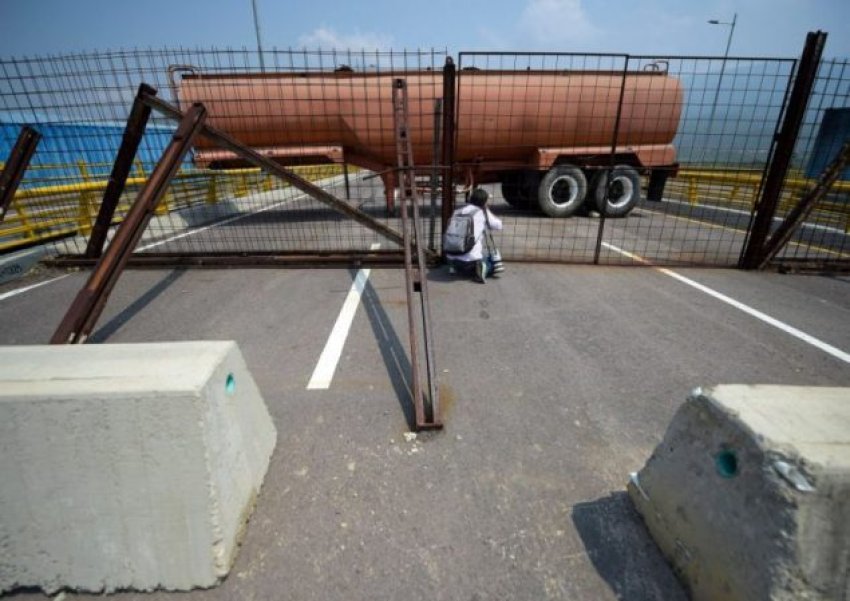
The cameras are focused on the border between Venezuela and Colombia. Everything has been prepared to present it as a door about to give in. It is just a matter of waiting for the right day, according to some presidents and news headlines.
The narrative of “imminence” has been key since Venezuelan opposition politician Juan Guaidó proclaimed himself president last month: the imminent fall of President Nicolás Maduro, imminent transition government and imminent resolution of all of Venezuela’s problems.
The reality when you arrive at the border is different, particularly along what has been built up as the “critical zone”: the municipalities of Simón Bolivar and Ureña, in the state of Táchira, across from the city of Cúcuta, Colombia.
We are meant to find a region in turmoil, militarised on the Venezuelan side and transformed in a huge depository for humanitarian aid on the Colombian side. The reality is different: a mix of normal life in one of the most complex borders of the continent and the sensation of a work in progress.
To understand the border’s dynamics we need to look at some factors.
First, the historical formation of that region as based on bi-national trade. The fluctuating flow of trade has been defined by the relation between the Venezuelan bolivar and Colombian peso.
Second, the emergence in 2013 of extractive smuggling as part of a plan to bleed the Venezuelan economy.
Third, the presence of key actors controlling smuggling operations, such as paramilitary groups.
Fourth, the fact that all three aforementioned factors co-exist in the particular context of the current economic situation.
These factors intersect and feed back into each other.
In this context, the cameras are focused on two crossings: the Las Tienditas bridge and the Simón Bolívar bridge.
The first one appeared on the cover of several newspapers due to the containers placed on the Venezuelan side, which was presented as a blockade. But this bridge was never open. Its construction was a Venezuelan initiative, which was sabotaged by Colombian policies that sought to expand illegal petrol smuggling instead of coming up with an ordered pricing system.
Petrol is key to understanding this border: one litre on the Colombian side costs about US$0.60, while on the Venezuelan side you can fill up a tank for less than a dollar.
The petrol smuggled over the border supplies the poorer areas on the Colombian side. This allows Colombian company Ecopetrol to distribute its produce in other areas while paramilitaries make millions and those who control the drug trade — the paramilitaries and cartels — have cheap petrol to process cocaine.
The Simón Bolívar bridge, meanwhile, is open to pedestrians from 6am to 9pm, and to trucks from 9am to 12pm. About 30,000 people cross it daily, most of whom cross and return on the same day.
For the cameras, it has the advantage of being narrow, which means a large queue can be easily created by simply holding up the line for a few minutes. This is what the Colombian authorities do when the media needs photos showing crowds. Otherwise, the transit of people is large and fluid.
The coming and going is for trade and family purposes. Certain products are cheaper on the Colombian side, so many people cross to buy products for personal use or to re-sell at a higher price on the Venezuelan side. Other regulated or subsidised products are cheaper on the Venezuelan side, so these tend to flow in the opposite direction.
This is an economy that involves thousands of people who live near the border, or in nearby states. They are pushed by economic difficulties derived from a combination of the financial blockade, the attack on the currency, and difficulties in containing inflation, among other factors.
It is on the basis of this daily routine that the narratives of humanitarian aid and international intervention are constructed. This border has been turned into a stage where the corporate media, spokespeople from different governments and international organisations converge. The aim is to present it as the critical point where the door will give in.
Everyone knows, for example, that the Las Tienditas bridge was never open, although they claim the Venezuelan government blocked it due to the current situation. Despite knowing the truth about the bridge, the media report the opposite.
The campaign to isolate Venezuela requires constructing a matrix, in which media outlets, government functionaries, organisations, presidents, social media influencers, and others are involved.
It is this context that humanitarian aid has become the battering ram with which to knock the door down, though with a few peculiar aspects.
First, the aid that has so far arrived is insignificant — just two trucks. Meanwhile the Local Committees of Supply and Production in Táchira distribute 40 trucks’ worth of food on any given day.
Second, the potential impact the aid doesn’t matter; what is important is setting the stage so the aid is on one side, the Venezuelan people are on the other asking for aid — the right wing will mobilise its forces to ensure this happens — and the government is in the middle blocking delivery.
This is an operation devised to justify new and more powerful attacks on Venezuela. They need to stir public opinion further, obtain written agreement in the US Senate to leave open the option of military intervention, and create internal commotion.
For the time being, however, everything is calm on the surface.
[Translated by Pedro Alvarez for Green Left Weekly from TeleSUR.]